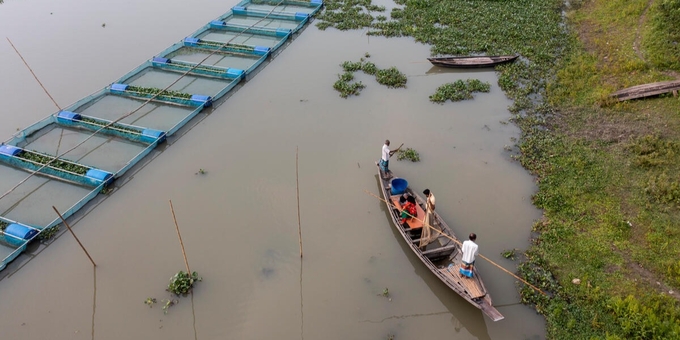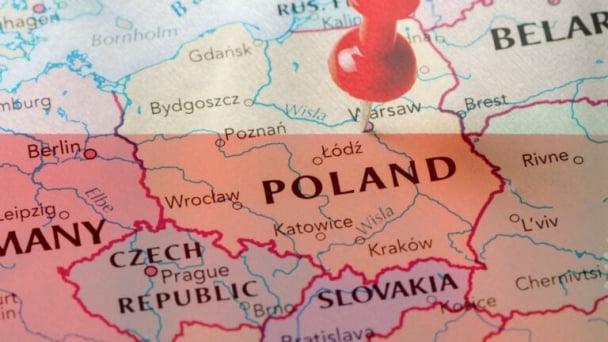June 22, 2025 | 05:29 GMT +7
June 22, 2025 | 05:29 GMT +7
Hotline: 0913.378.918
June 22, 2025 | 05:29 GMT +7
Hotline: 0913.378.918

Aquaculture growth indicates its capacity to further contribute to meeting the rising global demand for aquatic foods, but future expansion and intensification must prioritise sustainability and benefit regions and communities most in need.
World fisheries and aquaculture production has hit a new high, with aquaculture production of aquatic animals surpassing capture fisheries for the first time, according to a new report from the Food and Agriculture Organization of the United Nations (FAO) released today.
The 2024 edition of The State of World Fisheries and Aquaculture (SOFIA) said global fisheries and aquaculture production in 2022 surged to 223.2 million tonnes, a 4.4 percent increase from the year 2020. Production comprised 185.4 million tonnes of aquatic animals and 37.8 million tonnes of algae.
“FAO welcomes the significant achievements thus far, but further transformative and adaptive actions are needed to strengthen the efficiency, inclusiveness, resilience and sustainability of aquatic food systems and consolidate their role in addressing food insecurity, poverty alleviation and sustainable governance,” said FAO Director-General QU Dongyu. “That’s why FAO advocates Blue Transformation, to meet the overall requirements of better production, better nutrition, a better environment and a better life, leaving no one behind.”
The SOFIA report will be formally launched at the High-level event on ocean action “Immersed in Change” in San Jose, Costa Rica
Aquaculture produces record amount
In 2022 and for the first time in history, aquaculture surpassed capture fisheries as the main producer of aquatic animals. Global aquaculture production reached an unprecedented 130.9 million tonnes, of which 94.4 million tonnes are aquatic animals, 51 percent of the total aquatic animal production.
Aquaculture growth indicates its capacity to further contribute to meeting the rising global demand for aquatic foods, but future expansion and intensification must prioritise sustainability and benefit regions and communities most in need.
At present, a small number of countries dominate aquaculture. Ten of them – China, Indonesia, India, Viet Nam, Bangladesh, the Philippines, Republic of Korea, Norway, Egypt, and Chile – produced over 89.8 percent of the total. But many low-income countries in Africa and Asia are not using their full potential. Targeted policies, technology transfer, capacity building and responsible investment are crucial to boost sustainable aquaculture where it is most needed, especially in Africa.
Global consumption of aquatic foods rises again
Record production of aquatic foods underlines the sector’s potential in tackling food insecurity and malnutrition. Global apparent consumption of aquatic animal foods reached 162.5 million tonnes in 2021. This figure has increased at nearly twice the rate of the world population since 1961, with global per capita annual consumption rising from 9.1 kg in 1961 to 20.7 kg in 2022.
Of total aquatic animal production, 89 percent was used for direct human consumption, underscoring the critical role of fisheries and aquaculture in maintaining global food security. The rest was destined for indirect or non-food uses, mainly fishmeal and fish oil production.
Supporting further consumption from sustainable sources is crucial to foster healthy diets and improve nutrition worldwide. Aquatic foods provide high-quality proteins – 15 percent of animal proteins and 6 percent of total proteins worldwide – and key nutrients including omega-3 fatty acids, minerals, and vitamins. In 2021, they contributed at least 20 percent of the per capita protein supply from all animal sources to 3.2 billion people.
Most capture fisheries production comes from sustainable stocks
Global capture fisheries production has remained stable since the late 1980s. In 2022, the sector produced 92.3 million tonnes, comprising 11.3 million tonnes from inland and 81 million tonnes from marine capture. Despite the growth in aquaculture, capture fisheries remain an essential source of aquatic animal production.
The proportion of marine stocks fished within biologically sustainable levels, however, decreased to 62.3 percent in 2021, 2.3 percent lower than in 2019. When weighted by production level, an estimated 76.9 percent of the 2021 landings from stocks monitored by FAO were from biologically sustainable stocks. This underscores the role that effective fisheries management can play in facilitating stock recovery and increased catches, highlighting the urgent need to replicate successful policies to reverse the current declining trend.
FAO projects rise in production and consumption
SOFIA also contains FAO’s outlook for fisheries and aquaculture, which projects increases in world production and apparent consumption for the period up to 2032.
Aquatic animal production is expected to increase by 10 percent by 2032 to reach 205 million tonnes. Aquaculture expansion and capture fisheries recovery will account for this rise.
SOFIA projects that apparent consumption will increase by 12 percent to supply on average 21.3 kg per capita in 2032. Rising incomes and urbanisation, improvements in post-harvest practices and distribution and dietary trends are expected to drive most of this increase.
However, per capita apparent consumption in Africa will continue to decrease, as production projections may not keep up with population growth. This is especially alarming for sub-Saharan Africa where many countries are dependent on aquatic foods to meet their nutritional needs, particularly animal proteins and micronutrients.
The report also presents a scenario showing the potential implications of population dynamics on the supply of aquatic animal food up to 2050. Due to the rising global population, to maintain through to 2050 apparent consumption of aquatic animal foods at the 2022 estimated level of 20.7 kg per capita would require an increase in the total aquatic animal food supply of 36 million tonnes, a rise of 22 percent. This highlights the need to accelerate Blue Transformation priority actions in a world where aquatic foods play a more significant role in ending hunger, malnutrition and poverty.
Falling employment but vital livelihoods for millions
In addition to nutrition and food security, fisheries and aquaculture are an important source of livelihoods. According to the latest data, an estimated 61.8 million people were employed in the primary sector of fisheries and aquaculture in 2022, down from 62.8 million in 2020.
Sex-disaggregated data indicated that women made up 24 percent of the overall workforce but 62 percent in the processing subsector. Gender inequality issues remain, including differences in wages, insufficient recognition of women’s contribution to the sector, and gender-based violence.
SOFIA is an FAO flagship report that analyses the status and health of global fishery stocks as well as trends in fisheries and aquaculture at a global and regional level. The 2024 edition spotlights the concrete advances of Blue Transformation in action, showcasing the role of FAO, in collaboration with Members and partners, in driving change towards sustainable aquaculture expansion and intensification, effectively managed fisheries, and value chains that prioritize efficiency, safety and equity.
(FAO)

(VAN) Poultry production in Poland, which has only started recovering from devastating bird flu outbreaks earlier this year, has been hit by a series of outbreaks of Newcastle disease, with the veterinary situation deteriorating rapidly.

(VAN) Extensive licensing requirements raise concerns about intellectual property theft.

(VAN) As of Friday, a salmonella outbreak linked to a California egg producer had sickened at least 79 people. Of the infected people, 21 hospitalizations were reported, U.S. health officials said.

(VAN) With the war ongoing, many Ukrainian farmers and rural farming families face limited access to their land due to mines and lack the financial resources to purchase needed agricultural inputs.

(VAN) Vikas Rambal has quietly built a $5 billion business empire in manufacturing, property and solar, and catapulted onto the Rich List.

(VAN) Available cropland now at less than five percent, according to latest geospatial assessment from FAO and UNOSAT.

(VAN) Alt Carbon has raised $12 million in a seed round as it plans to scale its carbon dioxide removal work in the South Asian nation.